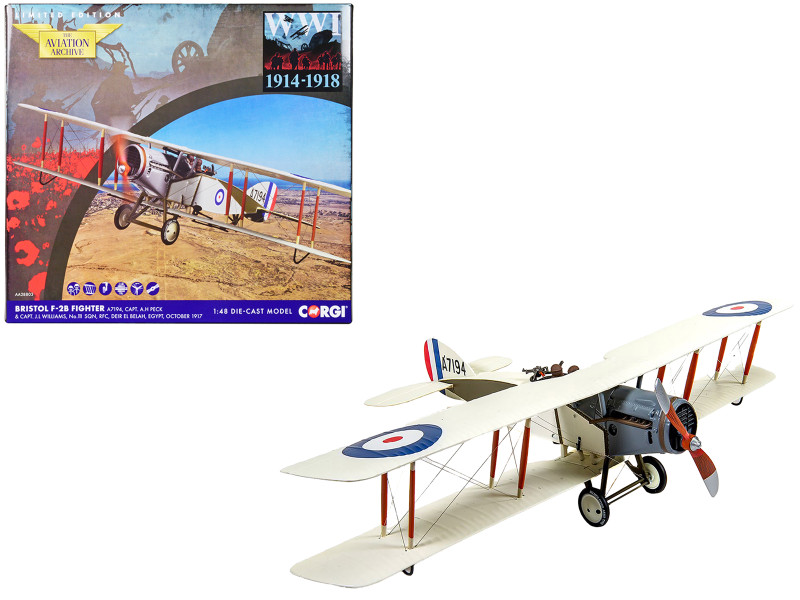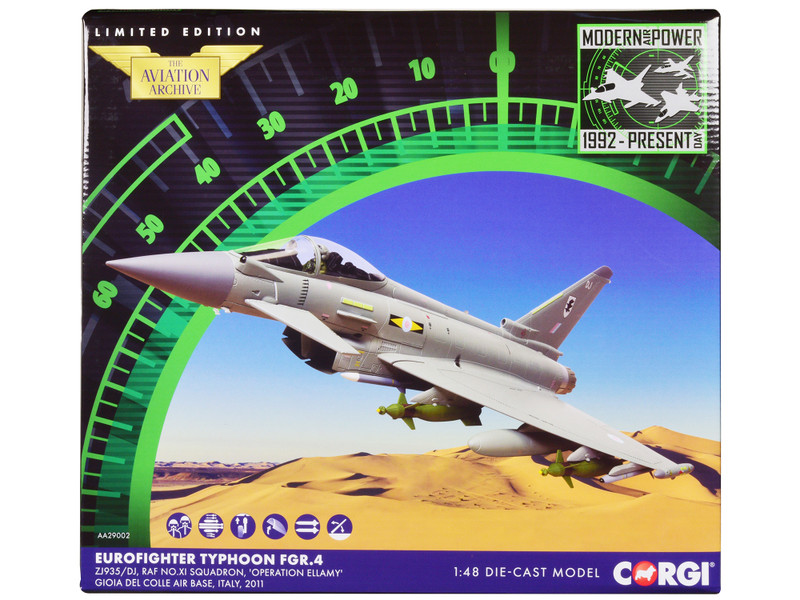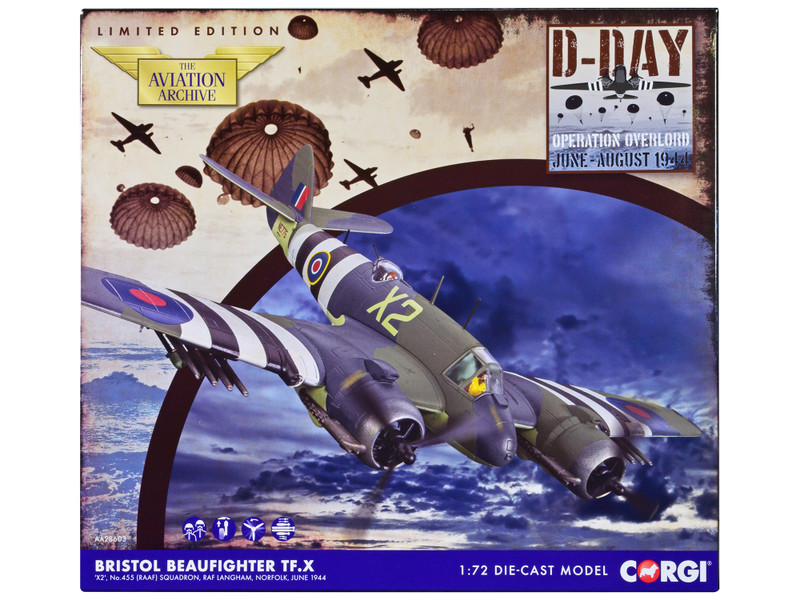- Home
- Military Models
- Bristol F-2B Fighter Aircraft "A7194 Capt. Arthur H Peck & Capt. John JL Williams No.111 Squadron Egypt" (1917) Royal Flying Corps "The Aviation Archive" Series 1/48 Diecast Model by Corgi
Bristol F-2B Fighter Aircraft "A7194 Capt. Arthur H Peck & Capt. John JL Williams No.111 Squadron Egypt" (1917) Royal Flying Corps "The Aviation Archive" Series 1/48 Diecast Model by Corgi
$91.04
RELATED ITEMS
-
 $173.49
$173.49 $96.99
$96.99 $184.99
$184.99 $65.24
$65.24SIGN UP FOR OUR NEWSLETTER
QUICK LINKS
CATEGORIES
- Accessories
- Winged Sprint Cars
- Acura Models
- AgustaWestland
- Ahrens Models
- Airbus
- Aichi
- Airco
- Aircrafts and War Planes
- Airfix Quickbuild Snap On Models
- Airspeed
- Airstream Models
- Albatros
- Alfa Romeo Models
- Ambulance Models
- AMC Models
- American LaFrance
- Antonov
- Aprilia Motorcycles
- Arado
- Armstrong Whitworth
- Aston Martin Models
- Audi Models
- ATV Models
- Auburn Models
- Austin Healey Models
- Austin / Morris Models
- Avro
- BAC
- BAE Systems
- Batmobile Models
- Beech
- Bell
- Bell Boeing
- Benelli Motorcycles
- Bentley Models
- Bleriot
- Bombardier
- BMW Models
- BMW Motorcycles
- Boeing
- Boeing-Stearman
- Boulton Paul
- Brewster
- Bristol
- Buffalo Models
- Bugatti Models
- Buick Models
- Bus Models
- Cadillac Models
- Camaro Models
- Caterpillar CAT
- Cessna
- Checker Models
- Chevrolet Models
- Chrysler Models
- Cirrus
- Citroen Models
- Coca Cola Models
- Consolidated
- Construction Models
- Convair
- Cord Models
- Corvette Models
- Curtiss
- Daimler Models
- Dassault
- Datsun Models
- De Havilland
- DeLorean Models
- Dennis Models
- DeSoto Models
- Dioramas
- Display Show Cases
- Dodge Models
- Dornier
- Douglas
- Ducati Motorcycles
- Duesenberg Models
- Edsel Models
- Elvis Presley's Cars
- Embraer
- Engine Replicas
- Eurocopter
- Eurofighter
- Fairey
- Fairchild Republic
- Fast & Furious Models
- Ferrari Models
- Fiat Models
- Figures
- Fire and Rescue Models
- Focke-Wulf
- Fokker
- Ford Models
- Formula 1 Models
- Freightliner Models
- Garbage Trucks
- Gas Pumps Models
- GasGas Motorcycles
- General Dynamics
- Gloster
- GMC Models
- Grumman
- Gulf Models
- Handley Page
- Harley Davidson
- Hawker
- Heinkel
- Helicopter Models
- Henschel
- Honda Models
- Honda Motorcycles
- Horten
- Hudson Models
- Hummer Models
- Husaberg Motorcycles
- Ilyushin
- Indian Motorcycles
- Indy Car Models
- Infiniti Models
- International Models
- Jaguar Models
- Jeep Models
- John Deere Models
- Junkers
- Kawasaki Airplanes
- Kawasaki Motorcycles
- Kenworth Models
- KhPZ
- Komatsu Models
- KTM Motorcycles
- Lamborghini Models
- Lancia Models
- Lavochkin
- Le Mans Models
- Lexus Models
- Leyland Models
- Limousine Models
- Lincoln Models
- Lippisch
- LLV (Long Life Vehicles)
- Lockheed
- Lockheed Martin
- Lotus Models
- LTV
- Lykan Models
- Macchi
- Mack Models
- Magirus Models
- MAN Tanks
- MAN Trucks
- Martin
- Maserati Models
- Maxim Models
- Maybach Models
- Mazda Models
- McDonnell Douglas
- McLaren Models
- Mercedes Models
- Mercury Models
- MG Models
- Military Models
- Mini Cooper Models
- MIL
- Mikoyan
- Mitsubishi Models
- Model Kits(To Built)
- Monster Trucks Models
- Morgan Models
- Movie/TV Series Models
- Mustang Models
- MV Agusta Bikes
- Nakajima
- NAMC
- NHRA Funny Cars
- Nissan Models
- North American
- North American Canadair
- Northrop
- Northtrop Grumman
- Norton Motorcycles
- 1/64 Scale Sets
- Oldsmobile Models
- Opel Models
- Other
- Pace Cars Models
- Packard Models
- Pagani Models
- Panavia
- Pennzoil Models
- Peterbilt Models
- Peugeot Models
- Pickup Trucks Models
- Pierce Models
- Plymouth Models
- Polaris Models
- Police Models
- Polikarpov
- Pontiac Models
- Porsche Models
- Rally Models
- RAM Models
- Range/Land Rover
- Renault Models
- REO Models
- Republic
- Rockwell
- Rolls Royce Models
- RV Models
- Ryan
- Saleen Models
- Scion Models
- Seagrave Models
- Shelby Models
- Shenyang
- Short
- Sikorsky
- Simca Models
- Sopwith
- Smart Models
- SPAD
- Studebaker Models
- Stutz Models
- Subaru Models
- Supermarine
- Sukhoi
- Suzuki Motorcycles
- Tanks and AFV's
- Taxi Models
- Tesla Models
- Texaco Models
- Tow Trucks Models
- Toyota Models
- Travel Trailers
- Triumph Models
- Triumph Motorcycles
- Tucker Models
- UPS Models
- USPS Models
- Vespa Models
- Vessels and Battle Ships
- Vickers
- Volkswagen Models
- Volvo Models
- Vought
- Western Star
- Westland
- Willys Models
- Wright
- Yakovlev
- Yamaha Motorcycles
- Zeppelin
- View all
All prices are in USD. © 2025 www.diecastdropshipper.com. Sitemap Powered by BigCommerce Copyright 2025 diecastdropshipper All Rights Reserved Terms & Conditions Privacy Policy Genius Ecommerce by 1Digital
 Loading... Please wait...
Loading... Please wait...









